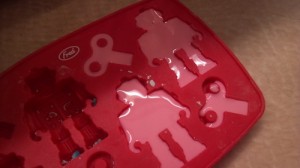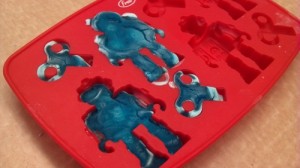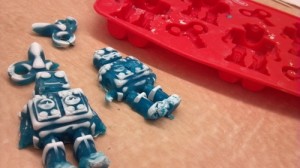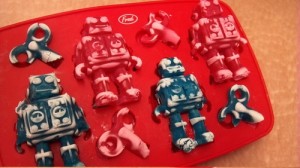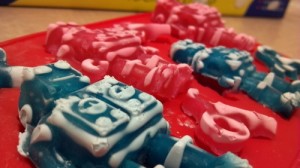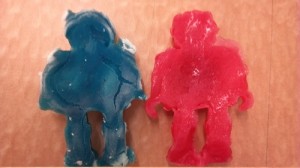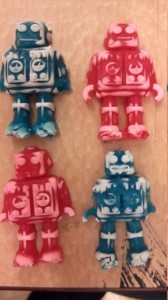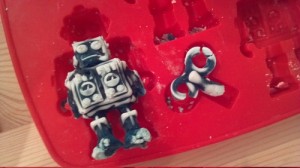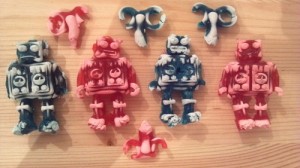Tiny bioplastic robots
When I discovered that the first meeting of my art class was devoted to playing with I made... tiny robots. Here's how.
Mix equal parts cornstarch and water, plus a tiny bit of oil (in this case, glycerin) and some food coloring in a plastic bag, then fill the ice cube tray molds (soft silicone, to make it easy to get the robots out later) to the top... (exact recipe at bottom of the post)
Then microwave for 30 seconds, aaaaaand... well, here's the blue batch (no, bioplastics don't turn red food coloring blue).
The first round (blue) was microwaved uncovered, and you can see that the cornstarch has settled unevenly (white places are mostly cornstarch) and that the plastic has cracked on the back. The pieces are hot and gummy-soft right when they come out; you have to let them cool and set to become less fragile before you can pop them out.
But boy, do they look great when they do. Again, note that the cornstarch has pooled at the parts of the robot that were at the bottom of the mold -- even if this was a 30-second microwave blast less than 10 seconds after mixing the liquid thoroughly in the bag.
Here's the intermediate result after all the robots came out of the microwave; they're still a bit gummy, definitely flexible, and the same size as the molds they came from. You'll also notice a few broken feet, hands, and incomplete "keys" (the things that aren't robots -- they're the kinds of keys you stick in the back of wind-up toys) because... have I mentioned that newly-made bioplastic is fragile and tears very easily?
Astute readers comparing this last picture to the first photo in this series will note that the liquid mixture is cloudy -- more like white paint with red mixed into it -- but that the microwaved robots cure into purer-colored, closer-to-transparent hues. In fact, if you don't put in food coloring at all, you'll be able to see through the bioplastic like a (slightly discolored, uneven) windowpane.
What's the difference between the blue and red robots (other than color)? Well, remember those cracks on the backs of the blue robots I pointed out earlier? I noticed this came from the liquid swelling in the microwave and then splitting open as it cooled and hardened once the microwave cycle ended. I wondered if I could prevent this by wrapping the surface of the liquid mixture with plastic wrap, which would constrain the swelling and give it a flat surface to mold into. As it turns out, I was right; the red (plastic-wrapped) robots bubbled up into the plastic wrap in the microwave, but pulled the wrap back down with it when they cooled, resulting in a smooth (if not incredibly flat) surface after unwrapping.
The robots weren't done, though. They had cooled and become stable enough to transport by the time I took them home late Tuesday night, but they were still gummy and flexible to the touch. Two days later, after all the water had evaporated from their little limbs...
Minibots! The bots have lost about 25% of their original height, which translates to a loss of about 46% of their original volume. (I'm doing a rough back-of-the-envelope calculation here; if you want to do this yourself and measure water displacement volume differences, go ahead -- I had a couple hundred pages of scholarly journal reading to do the same night.)
The final result. Two things to note here: the white parts (more cornstarch) are extremely delicate; with less polymerization to hold them together, they can be crumbled between your fingers with ease. Be careful when you move them, because they're brittle in those bits. (In other news, I have a legless red robot now.)
Also, remember the cracks on the back I was trying to eliminate? Well, it turns out I wasn't right in the long run. The blue bots (microwaved uncovered) had the cracks on their backs shrink down as they dried, and ended up with smoother, flatter backs than they had come out of the microwave with. Ironically, the initially-smooth backs of the red robots (microwaved covered with plastic wrap) shrunk and caved in as they dried, forming even bigger gashes and cracks in the process. So if you want a "smooth" object that most closely approximates the shape of your original mold, microwave it uncovered and trust the whole thing will shrink back together in the end.
Recipe:
- 2T cornstarch
- 2T water
- 6 drops glycerin
- 2 drops food coloring
Varying condition: Microwave the molds either uncovered or tightly covered with plastic wrap to see if it affects cracking of the final product.
Result: Although the plastic-wrapped products are smoother when they have just been taken out of the microwave, the uncovered products shrink and dry into a flatter, less caved-in final product.
A side note: This was fun to play with, and I did so in a freeform, informal quasi-experimental mode -- more "ooh, I wonder what happens?" than very specifically trying to isolate, control, and measure variables exactly. This writeup reflects the spirit of that play; I'm not satisfied with it as a thorough documentation of work done, but as a "hey, I did this thing and it was cool" chronicle, it does the job just fine. It's interesting to see how my notions of what makes a "proper" writeup affect the way I feel about this writing.
